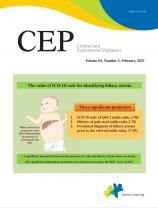Article Contents
| Clin Exp Pediatr > Volume 64(2); 2021 |
|
Abstract
Table┬Ā1.
| World Health Organization [8] | Centers for Disease Control and Prevention [9] | Royal College of Paediatrics and Child Health [10] | Korea Disease Control Agency [11] |
|---|---|---|---|
| Children and adolescents 0ŌĆō19 years of age with fever >3 days, AND 2 of the following: | An individual aged <21 years presenting with fever,* laboratory evidence of inflammation,ŌĆĀ and evidence of clinically severe illness requiring hospitalization, with multisystem (>2) organ involvement (cardiac, renal, respiratory, hematologic, gastrointestinal, dermatologic, or neurological). | 1. A child presenting with persistent fever (>38.5┬░C), inflammation (neutrophilia, elevated CRP, and lymphopaenia), and evidence of single or multiorgan dysfunction (shock, cardiac, respiratory, renal, gastrointestinal or neurological disorder) with additional features.b) This may include children fulfilling full or partial criteria for Kawasaki disease. | 1. Children and adolescents aged <19 years presenting with fever (>38.0┬░C) for >24 hours, laboratory evidence of inflammation (elevated ESR, CRP, fibrinogen, procalcitonin, D-dimer, ferritin, LDH, and IL-6; neutrophilia; lymphopenia; hypoalbuminemia), and evidence of 2 or more organs involvement (cardiac, renal, respiratory, hematologic, gastrointestinal, dermatologic or neurological disorder), who are in serious state requiring hospitalization; AND |
| 1. Rash or bilateral nonpurulent conjunctivitis or muco-cutaneous inflammation signs (oral, hands or feet). | |||
| 2. Hypotension or shock. | |||
| 3. Features of myocardial dysfunction, pericarditis, valvulitis, or coronary abnormalities (including echocardiographic findings or elevated troponin/NT-proBNP). | *Fever >38.0┬░C for >24 hours, or report of subjective fever lasting >24 hours | ||
| 4. Evidence of coagulopathy (by PT, PTT, elevated d-Dimers). | ŌĆĀIncluding, but not limited to, one or more of the following: an elevated CRP, ESR, fibrinogen, procalcitonin, d-dimer, ferritin, lactic acid dehydrogenase (LDH), or interleukin 6 (IL-6), elevated neutrophils, reduced lymphocytes and low albumin. | 2. Exclusion of any other microbial cause, including bacterial sepsis, staphylococcal or streptococcal shock syndromes, infections associated with myocarditis such as enterovirus (waiting for results of these investigations should not delay seeking expert advice). | 2. Exclusion of any other microbial cause of inflammation (bacterial sepsis, staphylococcal or streptococcal toxic shock syndrome, enteroviral myocarditis etc.); AND |
| 5. Acute gastrointestinal problems (diarrhoea, vomiting, or abdominal pain). | |||
| AND Elevated markers of inflammation such as ESR, CRP, or procalcitonin. | AND No alternative plausible diagnoses. | 3. Evidence of current or recent SARS-CoV-2 infection (positive PCR, antibody or antigen test; or COVID-19 exposure within 4 weeks prior to the onset of the illness) (additional commentsa)) | |
| AND No other obvious microbial cause of inflammation, including bacterial sepsis, staphylococcal or streptococcal shock syndromes. | AND Positive for current or recent SARS-CoV-2 infection by RTPCR, serology, or antigen test; or COVID-19 exposure within 4 weeks prior to the onset of symptoms (additional commentsa)) | 3. SARS-CoV-2 PCR testing may be positive or negative. | |
| AND Evidence of COVID-19 (RT-PCR, antigen test or serology positive), or likely contact with patients with COVID-19. |
NT-proBNP, N-terminal prohormone of brain natriuretic peptide; PT, prothrombin time; PTT, partial thromboplastin time; ESR, erythrocyte sedimentation rate; CRP, C-reactive protein; COVID-19, coronavirus disease 2019; RT-PCR, reverse transcription-polymerase chain reaction; SARS-CoV-2, severe acute respiratory syndrome coronavirus 2.
a) Additional comments: (1) Some individuals may fulfill full or partial criteria for Kawasaki disease but should be reported if they meet the case definition for MIS-C. (2) Consider MIS-C in any case of pediatric death with evidence of SARS-CoV-2 infection.
b) Additional features: oxygen requirement, hypotension, abdominal pain, confusion, conjunctivitis, cough, diarrhea, headache, lymphadenopathy, mucus membrane changes, neck swelling, rash, respiratory symptoms, sore throat, swollen hands and feet, syncope, vomiting, abnormal fibrinogen level, absence of potential causative organisms (other than SARSCoV-2), high D-dimer level, high ferritin level, hypoalbuminemia, acute kidney injury, anemia, coagulopathy, high interleukin-6 or -10 level, proteinuria, increased creatine kinase level, increased lactate dehydrogenase level, increased triglyceride level, increased troponin level, thrombocytopenia, transaminitis, abnormal echocardiography findings (myocarditis, valvulitis, pericardial effusion, coronary artery dilatation), abnormal chest roentgenographic findings (patchy infiltrates, pleural effusion), abnormal abdominal ultrasonography findings (colitis, ileitis, lymphadenopathy, ascites, hepatosplenomegaly).
Table┬Ā2.
| Country | No. of patientsa) | Age (yr), median (range) | No. of deaths |
|---|---|---|---|
| United States [15] | 438 (male, 250) | 8.3 (0ŌĆō20) | 7 |
| United Kingdom [15] | 128 (male, 75) | 10 (4ŌĆō17) | 3 |
| France [15] | 202 (male, 100) | 9 (2ŌĆō16) | 1 |
| Italy [15] | 12 (male, 8) | 7.5 (2.9ŌĆō16) | 0 |
| Spain [20] | 30 (male, 18) | 7.6 | 1 |
| Switzerland [15] | 3 (male, 1) | 10 (10ŌĆō12) | 0 |
| Germany [15] | 1 (mal,e 1) | 5 | 1 |
| Latin America [21] | 95 | ? | ? |
| South Korea [16] | 3 (male, 2) | 12 (11ŌĆō14) | 0 |
| India [17] | 23 (male, 11) | 7.2 | 1 |
| Pakistan [18] | 8 (male, 5) | 5 (1ŌĆō16) | 2 |
| Iran [19] | 45 (male, 24) | 7 (0.83ŌĆō17) | 5 |








 PDF Links
PDF Links PubReader
PubReader ePub Link
ePub Link PubMed
PubMed Download Citation
Download Citation


